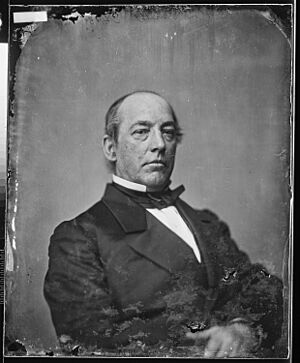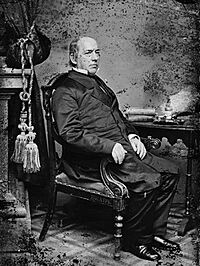Caleb B. Smith facts for kids
Quick facts for kids
Caleb B. Smith
|
|
|---|---|
 |
|
| Judge of the United States District Court for the District of Indiana | |
| In office December 22, 1862 – January 7, 1864 |
|
| Appointed by | Abraham Lincoln |
| Preceded by | Elisha Mills Huntington |
| Succeeded by | Albert Smith White |
| 6th United States Secretary of the Interior | |
| In office March 5, 1861 – January 1, 1863 |
|
| President | Abraham Lincoln |
| Preceded by | Jacob Thompson |
| Succeeded by | John Palmer Usher |
| Member of the U.S. House of Representatives from Indiana's 4th district |
|
| In office March 4, 1843 – March 3, 1849 |
|
| Preceded by | James H. Cravens |
| Succeeded by | George Washington Julian |
| Personal details | |
| Born |
Caleb Blood Smith
April 16, 1808 Boston, Massachusetts, US |
| Died | January 7, 1864 (aged 55) Indianapolis, Indiana, US |
| Political party | Whig (before 1854) Republican (from 1854) |
| Education | University of Cincinnati Miami University |
| Signature | |
Caleb Blood Smith (born April 16, 1808 – died January 7, 1864) was an important American politician and judge. He served as a United States Representative for Indiana. He was also the 6th United States Secretary of the Interior, working for President Abraham Lincoln. Later in his life, he became a United States district judge.
Contents
Early Life and Career
Caleb Blood Smith was born on April 16, 1808, in Boston, Massachusetts. When he was six years old, his family moved to Ohio. He went to Miami University and the University of Cincinnati. In 1828, he became a lawyer.
Smith started his own law practice in Connersville, Indiana. He also founded and edited a newspaper called the Indiana Sentinel in 1832. He was elected to the Indiana House of Representatives several times. He even served as the Speaker of the House in 1836.
Serving in Congress
Smith tried to become a U.S. Representative in 1841 but didn't win. However, he was later elected as a member of the Whig Party to the United States House of Representatives. He represented Indiana's 4th congressional district.
He served in Congress from March 4, 1843, to March 3, 1849. During his time, he was the Chairman of the Committee on Territories. This committee dealt with issues in areas that were not yet states.
Later Public Service
After his time in Congress, President Zachary Taylor asked Smith to join a special board. This board helped settle claims against Mexico from 1849 to 1851. After this, he went back to being a lawyer in Cincinnati, Ohio.
In 1861, Smith attended the Peace Convention of 1861 in Washington, D.C.. This meeting was an effort to find ways to prevent the American Civil War from starting.
Working for President Lincoln
President Abraham Lincoln chose Caleb Smith to be the 6th United States Secretary of the Interior. He served in this role from March 5, 1861, to January 1, 1863.
Smith wasn't very interested in the job and had poor health. So, he often let his assistant, John Palmer Usher, handle most of the work. When President Lincoln shared his plan for the Emancipation Proclamation, Smith was hesitant. However, he eventually accepted Lincoln's decision.
Becoming a Federal Judge
On December 16, 1862, President Lincoln nominated Smith to become a judge. He was to serve on the United States District Court for the District of Indiana. The United States Senate approved his nomination quickly.
Smith became a judge on December 22, 1862. Sadly, his time as a judge was short. He passed away on January 7, 1864, in Indianapolis, Indiana.
The Mystery of His Burial Place
Caleb Smith was first buried at Greenlawn Cemetery in Indianapolis. However, his wife, Elizabeth, was worried about his body being disturbed. She feared that people from the South might desecrate graves during the Civil War. She also worried about local teens causing damage.
Because of her fears, Elizabeth moved his body to Crown Hill Cemetery in Indianapolis when it opened. Even though there is a mausoleum at Crown Hill, Caleb Smith is not buried there.
For many years, people have tried to find where Caleb Smith's body is truly buried. In 1977, an investigation was done at the Connersville City Cemetery. Family members gave permission to search a specific plot. However, Caleb Smith's body was not found there either. Only his son-in-law was found. The exact location of Caleb Blood Smith's final resting place remains a mystery.
Freemasonry
Caleb Smith was also a Freemason. He joined Warren Lodge No. 15 in Connersville in 1829. He became the Grand Master of the Grand Lodge of Indiana in 1837.
Today, the highest award given by the Grand Lodge of Indiana is called the Caleb B. Smith Medal of Honor. Smith's former home in Connersville, known as Elmhurst, is now home to the Connersville Masonic Lodge #15. This historic home is listed on the National Register of Historic Homes.
Sources
- The Department of Everything Else: Highlights of Interior History (1989)
- "Weird Mystery" a story about Caleb Blood Smith, can be found at www.libraries.iub.edu by typing in the search bar. This is a story written by John Walker and co-written by Cynthia Long, John Walker's granddaughter.
- Sanford, Wayne L. "Cemeteries" The Encyclopedia of Indianapolis. Bloomington: Indiana University Press, 1994. googlebooks Retrieved May 21, 2009
- Weird Mystery
| United States House of Representatives | ||
|---|---|---|
| Preceded by James H. Cravens |
Member of the U.S. House of Representatives from Indiana's 4th congressional district 1843–1849 |
Succeeded by George Washington Julian |
| Political offices | ||
| Preceded by Jacob Thompson |
U.S. Secretary of the Interior Served under: Abraham Lincoln 1861–1863 |
Succeeded by John Palmer Usher |
| Legal offices | ||
| Preceded by Elisha Mills Huntington |
Judge of the United States District Court for the District of Indiana 1862–1864 |
Succeeded by Albert Smith White |


